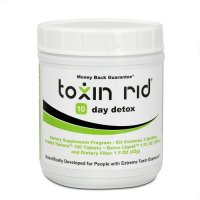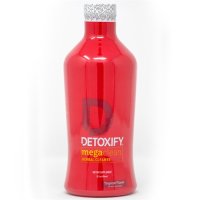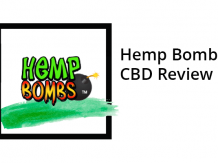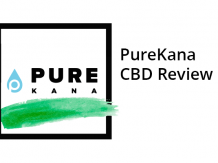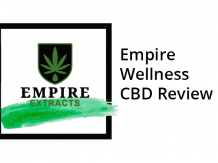Endoca Hemp CBD Review
Our Rating: C-. Waiting on 3rd party labs.
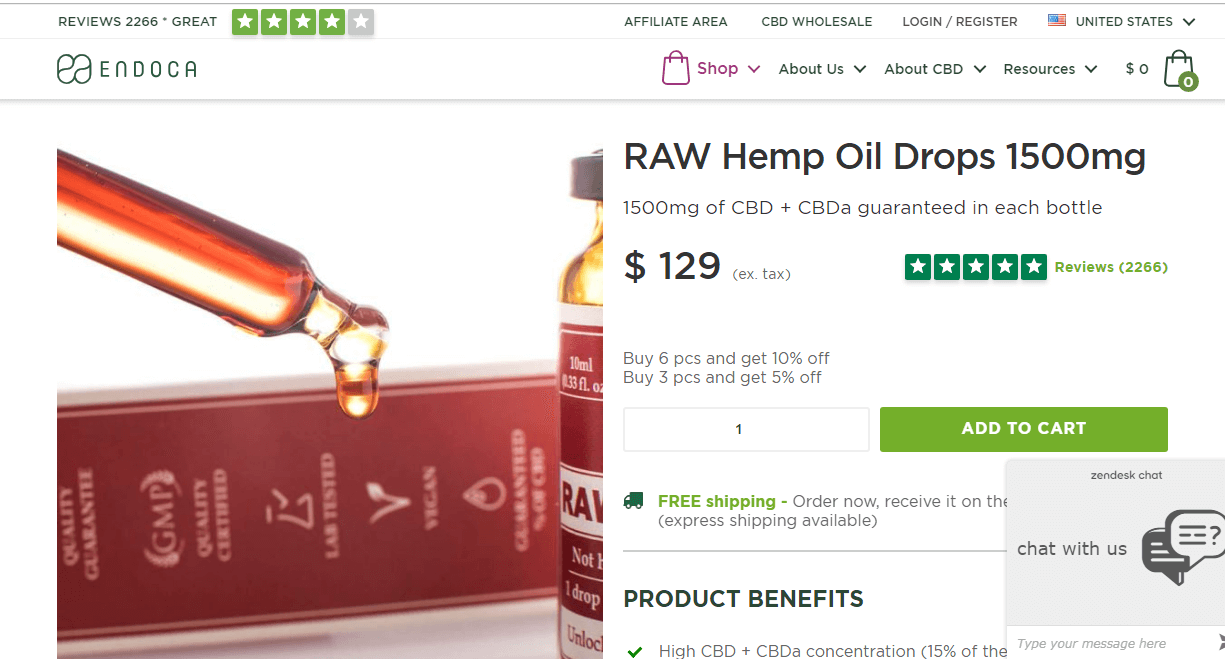
Figure 1.
Overall Grade: C minus.
The first thing you see on their website is a rating from Trustpilot of 4 stars. We are not familiar enough to say if this has any meaning. However, it is a bad sign for ratings by an interested party to be displayed as if it were trustworthy or objective. The website is ‘advertising-esque’, which is also a bad sign. Companies that have a powerful product only need to put facts on their website. Companies that are struggling to sell ineffective products have to flood you with advertising and unrealistic images.
Consider the picture below from the home page:

Is Endoca CBD gonna cause magical, multi-color bubbles to drizzle down your throat and purify your body? Is that what’s in the picture? I don’t believe that is how cannabidiol works at all. Pictures should be informative and give some explanation about the product in general.
The website also advertises low to high CBD content. This is a strange thing to say. Does anyone really want low CBD? You should expect low CBD in Endoca hemp oil products, that’s fine. But generally, you want low toxins, low mycotoxin, low pesticide levels, but not low CBD. It could be by low CBD, they actually mean high CBDa, or high MCTs and phytonutrients, in which cause it’s just an oversight by the website writer. We will see later if they honestly label their products. However, even if they do, it’s easy to make up good labels if you don’t really run the tests that are necessary.
| Is its CBD oil? | Yes. |
| Old, the trusted company? | No. |
| Contains verified therapeutic levels of CBD? | No. |
| Sourced in the United States? | No. Scandinavia. |
| Sourced in Europe? | Yes. |
| Certified Organic in the US? | No. |
| Certified Organic by the European Commission? | Unknown. |
| Did the lab test in the United States? | Unknown. |
| 3rd Party Testing? | Claimed, but not available on their website. |
| Do they tell what percentage CBD in the product? | Yes. |
Going by these test questions alone, we would advise great caution if considering Endoca products. As well, the lack of available 3rd party labs is a non-negotiable minus.
Advantages of Endoca Hemp Oil
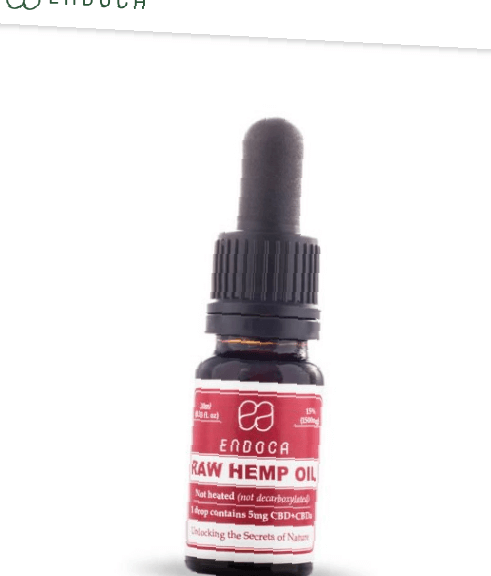
Endoca stands out because it has a wide variety of products including balms and CBD chewing gum.
Also, on its website, Endoca does a superior job of labeling its products. It tells you how to take of each product and exactly how much of each therapeutic substance is in each drop of the product.
Lab Analyses
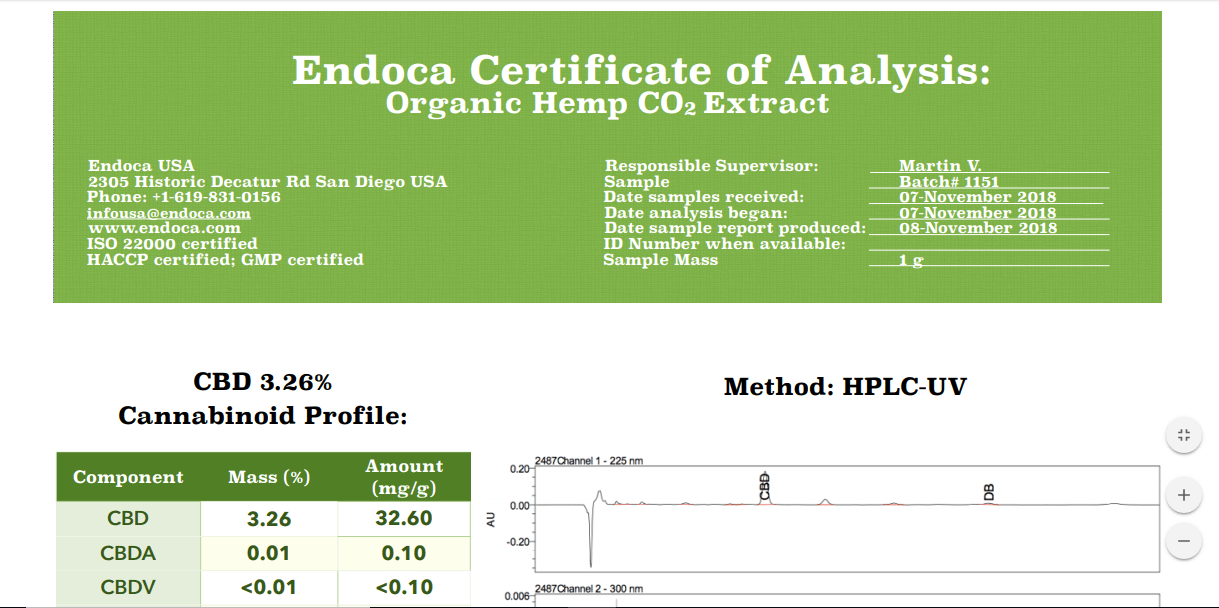
Certificates of analysis for Endoca products are available at https://www.endoca.com/quality-reports. These certificates appear to be from Endoca’s in-house lab. This is a major oversight. We advise never to buy a product which will not post 3rd party labs. Often, they do this because they know that many of their batches won’t pass the quality test. Also, social media reports about Endoca’s products are hit and miss, more so than our most trusted CBD producers.
After a chat with representatives, we were told we will be sent a third-party lab by contacting [email protected] Until we receive positive 3rd party lab results, we will have to consider Endoca a no go.
Endoca Hemp prices and products
You can get right into the shopping from the homepage, this is a good sign. Endoca does have some innovative products, including CBD gum and suppositories. Also, they include both CBD and CBD A in the products. But can they prove the levels in their products?
| CBD Oil | CBD Capsules and Pills | Skin Care | CBD Extract | CBD Suppositories | Cannabis Crystals | CBD Tincture |
|---|---|---|---|---|---|---|
| RAW CBD Hemp Oil Drops 1500mg $ 129 |
RAW Hemp Oil Capsules 1500mg of CBD+CBDa $ 129 |
Hemp Salve (750mg CBD) $ 64 |
RAW Hemp Oil 2000mg CBD + CBDa $ 199 |
CBD Suppositories Total: 500mg CBD $ 52 |
Cannabis Crystals 99% 500mg (Pure CBD) $ 48 |
RAW Hemp Oil Drops 1500mg $ 129 |
| Hemp Oil Drops 1500mg CBD (Cannabidiol) (15%) $ 129 |
Capsules Hemp Oil Total: 1500mg CBD $ 129 |
Hemp Whipped Body Butter (1500mg CBD) $ 145 |
30% CBDa + CBD (3000mg) $ 286 |
Hemp Oil Drops 1500mg CBD (Cannabidiol) (15%) $ 129 |
||
| RAW Hemp Oil Drops 300mg CBD + CBDa (3%) | RAW Hemp Oil Capsules 300mg of CBD+CBDa $ 31 |
CBD Lips + Skin 20mg CBD $ 8 |
RAW Hemp Oil Drops 300mg CBD + CBDa (3%) $ 31 |
|||
| Hemp Oil Drops 300mg CBD (Cannabidiol) (3%) $ 31 |
Capsules Hemp Oil Total: 300mg CBD $ 31 |
Hemp Oil Drops 300mg CBD (Cannabidiol) (3%) $ 31 |
||||
| CBD Chewing Gum 150mg $ 15 |
||||||
Ingredients
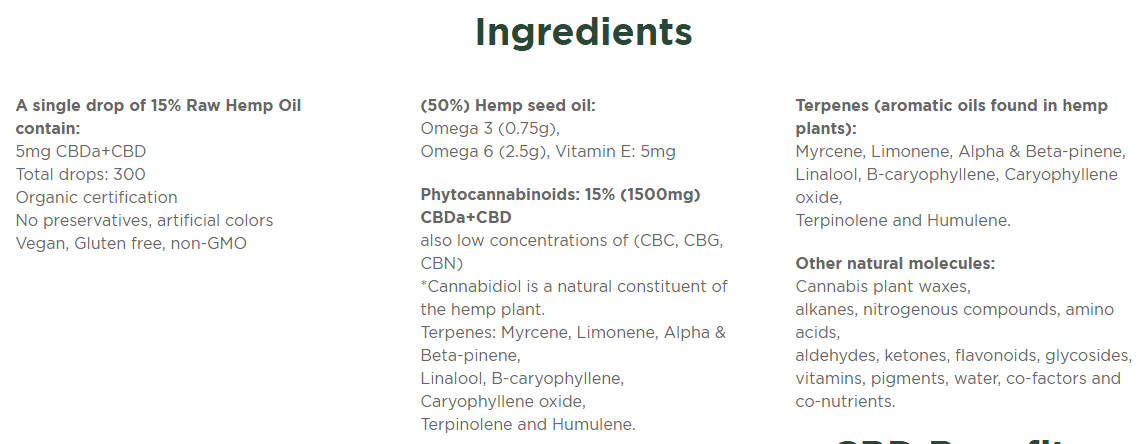
These are the ingredients listed on the website for Endoca Raw Hemp oil. We have to give Endoca props for this. They list each substance contained in the product, how much by percent and milligram, other molecules that are not central to the mechanism, and inactive ingredients. The one thing we have to fault them on is not telling us how much CBDa there is versus how much CBD. However, many CBD enthusiasts urge users to take both CBDa and CBD rather than just CBD, so there may, in fact, be a benefit to this, but this is not scientifically known, as CBDa hasn’t been well-studied compared to CBD. Also, since this is Raw Hemp oil, if one wants CBD, they should get CBD Hemp oil where the CBD has been activated.
CBD stands for cannabidiol. Cannabidiol is the most therapeutic substance in medical hemp. It is often the cannabinoid with the highest content in industrial hemp plants which have little psychoactive THC and no psychoactive effect. Cannabidiol will not make you high. CBD stands for cannabidiol acid. This is a non-activated form of cannabidiol which will become cannabidiol when heated at the right temperature for the right amount of time. Some well-versed researchers say that CBDa has different therapeutic effects than CBD, mainly of an anti-inflammatory nature.
Omega 3 and 6 acids are known to have positive effects on health when they are taken in a healthy balance. You want to have more omega 3 than omega 6 because omega 6 acids can have some inflammatory effects. The hemp seed oil contains both, but, there is more Omega 6, so this is not a healthy balance. However, the amount one would take would not likely be enough to cause negative health effects and the many anti-inflammatory ingredients in the hemp oil will likely suppress any resultant inflammation.
We give Endoca an A for listing and explaining ingredients, but that’s not the entire story. If you can’t prove with 3rd party labs that your product contains these ingredients, that’s mean the customers may doubt if all of these ingredients are really in the product.
How to Use
Vaping
Endoca does not appear to have any vape products. This is actually a good sign. Serious companies don’t often have vape products. This is likely because vaping has not proven to be safe and effective. It is not known if vaping can deliver a therapeutic cannabidiol dose.
Dabbing
Endoca sells a CBD Concentrate. It is not known if it can be used as a dab in an oil rig. Smoking a product not meant to be smoked can lead to health problems like lung damage.
Edibles
Several of Endoca’s products are edible. The CBD Oils, CBD capsules and pills, CBD extract, Cannabis Crystals, and CBD Tinctures are all potentially edible.
Sublingual
CBD Tinctures can be potentially taken under the tongue as well as CBD oils.
Topical application
Endoca has topical balms containing CBD and/or CBDa. Its oils can also be applied topically.
Tinctures
Endoca has several tincture products. The tincture can be added to foods. Sometimes tinctures can be taken sublingually, but tinctures with high alcohol content can burn under the tongue.
Dosage
CBD Oil Dosages
RAW Hemp Oil Drops 1500mg
$ 129
One drop contains 5 mg of CBD/CBDa. Therefore a typical beginning dose for anxiety maybe about 5 drops or 25 mg of CBD+CBDA.
For chronic pain, you might take 20 mg per day or 4 drops.
For non-medical anxiety in people who have epilepsy, up to 300 mg or 60 drops in divided doses throughout the day.
For the inability to sleep well at night, 8 drops, or 40 mg before bedtime daily.
For stress and tension in a person who has Huntington’s disease, 10 mg per kilogram of body weight or two drops per kilogram of body weight.
For stress and tension in a person who has schizophrenia, up to 1,280 mg or 256 drops per day.
For glaucoma, absolutely no more than 40 mg or 8 drops per day. Higher doses can worsen symptoms.
Hemp Oil Drops 1500mg CBD (Cannabidiol) (15%)
$ 129
One drop contains 5 mg of CBD. Therefore, a typical beginning dose for anxiety maybe about 5 drops or 25 mg of CBD.
For chronic pain, you might take 20 mg per day or 4 drops.
For non-medical anxiety in people who have epilepsy, up to 300 mg or 60 drops in divided doses throughout the day.
For the inability to sleep well at night, 8 drops, or 40 mg before bedtime daily.
For stress and tension in a person who has Huntington’s disease, 10 mg per kilogram of body weight or two drops per kilogram of body weight.
For stress and tension in a person who has schizophrenia, up to 1,280 mg or 256 drops per day.
For glaucoma, absolutely no more than 40 mg or 8 drops per day. Higher doses can worsen symptoms.
RAW Hemp Oil Drops 300mg CBD + CBDa (3%)
One drop contains 5 mg of CBD. Therefore, a typical beginning dose for anxiety maybe about 5 drops or 25 mg of CBD.
For chronic pain, you might take 20 mg per day or 4 drops.
For non-medical anxiety in people who have epilepsy, up to 300 mg or 60 drops in divided doses throughout the day.
For the inability to sleep well at night, 8 drops, or 40 mg before bedtime daily.
For stress and tension in a person who has Huntington’s disease, 10 mg per kilogram of body weight or two drops per kilogram of body weight.
For stress and tension in a person who has schizophrenia, up to 1,280 mg or 256 drops per day.
For glaucoma, absolutely no more than 40 mg or 8 drops per day. Higher doses can worsen symptoms.
Hemp Oil Drops 300mg CBD (Cannabidiol) (3%)
$ 31
One drop contains 1 mg of CBD. Therefore, a typical beginning dose for anxiety maybe about 25 drops or 25 mg of CBD.
For chronic pain, you might take 20 mg per day or 20 drops.
For non-medical anxiety in people who have epilepsy, up to 300 mg or 300 drops in divided doses throughout the day.
For the inability to sleep well at night, 40 drops, or 40 mg before bedtime daily.
For stress and tension in a person who has Huntington’s disease, 10 mg per kilogram of body weight, or ten drops per kilogram of body weight.
For stress and tension in a person who has schizophrenia, up to 1,280 mg or 1,280 drops per day.
For glaucoma, absolutely no more than 40 mg or 40 drops per day. Higher doses can worsen symptoms.
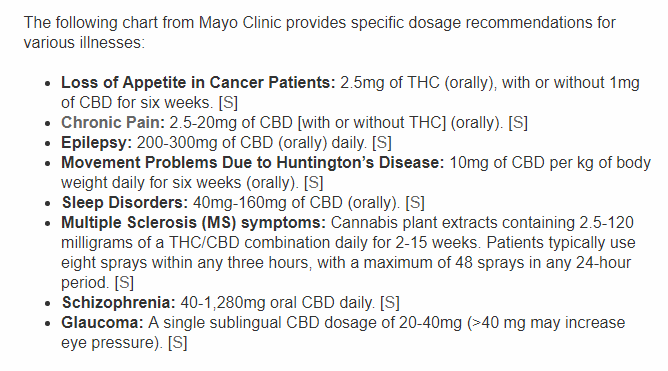
How it Works
Endoca’s products have cannabidiol as the main active ingredient. Cannabidiol is known to have many mechanisms of action. We list the receptors in the central nervous system which cannabidiol binds to below. These include cannabinoid receptors, serotonin receptors, and orphan receptors which are related to cannabinoid receptors by their structure. CBD also modulates opioid receptors by which it affects pain perception. These are not the only receptors cannabidiol may bind to or effect.
Cannabidiolic acid (CBDa) have been shown to have the following effects:
- Fighting nausea (Rock, Limebeer, & Parker, Effect of combined doses of Δ 9 -tetrahydrocannabinol (THC) and cannabidiol acid (CBDA) on acute and anticipatory nausea using rat (Sprague- Dawley) models of conditioned gaping, 2015)
- Breast Cancer growth inhibitor (Takeda, et al., 2012)
- Anxiety fighter (Pertwee, et al., 2018)
- Vomiting fighter (Bolognini, et al., 2013)
- Depression fighter (Hen-Shoval, et al., 2018)
- Diarrhea fighter (Cluny, et al., 2011)
- Studied for inflammatory pain (Rock, Limebeer, & Parker, Effect of cannabidiol acid and ∆9-tetrahydrocannabinol on carrageenan-induced hyperalgesia and edema in a rodent model of inflammatory pain., 2018)
Cannabidiol (CBD) has been shown to have the following effects:
- Anti-cancer (Massi, Solinas, Cinquina, & Parolaro, 2013).
- Anti-infarction (Hayakawa, et al., 2004).
- Anti-psychotic (Iseger, Bossong, & Bossong, 2015).
- Anti-seizure activity, known about in 1973 (Izquierdo, Orsingher, & Berardi, 1973).
- Attenuates the adverse effects of THC (Henquet & Kuepper, 2010).
- Can fight memory loss caused by marijuana THC (Morgan, Schafer, Freeman, & Curran, 2010). This means that medical marijuana should be enriched with extra cannabidiol to avoid memory loss and psychotic effects
- Fights cerebral infarction by modulating serotonin (Mishima, et al., 2005).
- Fights migration of cancer cells (Kapoor, 2013).
- Fights myocardial ischemia-reperfusion injury (Durst, et al., 2007).
- Inhibiting angiogenesis feeds cancers (Solinas, et al., 2012).
- May fight autoimmune diabetes (Weiss, et al., Cannabidiol arrests the onset of autoimmune diabetes in NOD mice, 2008)
- May fight colon cancer (Aviello, et al., 2012).
- May fight neurodegeneration (Iuvone, Esposito, Filippis, Scuderi, & Steardo, 2009).
- May help in colitis (Borrelli, et al., 2009).
- May reduce immune system inflammatory responses (Kozela, et al., 2010).
- Modulates sleep (Murillo-Rodríguez, Millán-Aldaco, Palomero-Rivero, Mechoulam, & Drucker-Colín, 2006).
- Neuroprotective (Hampson, Grimaldi, Axelrod, & Wink, 1998).
- Prevents diabetes (Weiss, et al., Cannabidiol lowers the incidence of diabetes in non-obese diabetic mice, 2006)
- Reduces anxiety in the right doses (Fusar-Poli, et al., 2009).
- Vasorelaxation (Stanley, Hind, Tufarelli, & O’Sullivan, 2015).
- Wakefulness-promoting, modulation of circadian rhythms (Murillo-Rodríguez, et al., 2014).
Cannabidiol and cannabidiolic acid work by binding to various receptor targets throughout the central nervous system and the rest of the body. Acting at these receptor sites, it exerts influence on the metabolism of various neurotransmitter systems. It seems like ‘snake oil’ that one compound can have all the beneficial effects listed above; however, cannabinoid receptors exist throughout the nervous system and it is known that such a ubiquitous receptor must be involved in nearly everything the nervous system does, just like serotonin and dopamine receptors. Dopamine affects pleasure, but also pain. Anxiety and also relaxation. Heart contraction and blood pressure. All of these systems are integrated so cannabinoid receptors will indeed have effects on all of these systems and exogenous cannabinoids from plants can definitely have therapeutic effects that are extensive.
Mechanisms of action of CBD and CBDa
- CB1 receptor agonist
- CB2 receptor agonist
- Glitazone receptor agonist
- GPR12 (inverse agonist)
- GPR3 (inverse agonist)
- GPR55 (antagonist) receptors
- GPR6 (inverse agonist)
- Inhibitor of fatty acid amide hydrolase, increasing levels of endogenous cannabinoids
- Serotonin 5-HT1A receptor partial agonist
- An allosteric modulator of mu and sigma opioid receptors (Kathmann, Flau, Redmer, Tränkle, & Schlicker, 2006)
The action of CBD and CBDa produces anti-inflammatory, anti-pain, and anti-seizure effects which can be beneficial to address a range of discomforts.
Manufacturer, Support, Certificates
| Endoca | |
|---|---|
 Address
|
Endoca USA 2305 Historic Decatur Rd San Diego the USA Endoca BV Siriusdreef 17 2132 WT Hoofddorp EU |
 Phone
|
+ +1-619-831-0156 – US
+31-235-689-151 |
 Contact
|
https://www.endoca.com/contact-us |
 Email
|
[email protected] |
Does CBD have any side effects?
CBD is unlikely to have many side effects under 300 mg daily. Above that dosage, one should consult a doctor. CBDa is also not known to have many side effects.
Before we look at the side effects, let’s look at the safety. Consider these facts:
CBD and CBDa Safety facts
- Does not induce changes in food intake
- Does not induce catalepsy
- CBD is non-toxic
- Does not affect physiological parameters such as:
- Heart rate
- Blood pressure
- Body temperature
- Does not affect gastrointestinal movement
- Does not alter the psychomotor function
- It does not alter psychological functions.
- Chronic use and high doses up to 1,500 mg/day of CBD are reportedly well tolerated in humans.
- Heart rate
- Blood pressure
- Body temperature
(Bergamaschi, Queiroz, Zuardi, & Crippa, 2011)
Possible Negative Side Effects of CBD
- Tiredness
- Inhibition of hepatic drug metabolism
- Decreased fertilization capacity
- Decreased activities of p-glycoprotein and other drug transporters
- Alterations of in vitro cell viability
- Sleepiness
- Poor quality sleep
- Insomnia
- Diarrhea
- Decreased appetite
- Changes in appetite
In general, CBD is safe and well-tolerated. Doses above 300 mg should have a doctor’s monitoring.
Pros and cons
| Pros of Endoca CBD Oil |
|
| Cons of Endoca CBD products |
|
Endoca Hemp CBD Oil reviews
Review Rating: A. “I picked this one…”

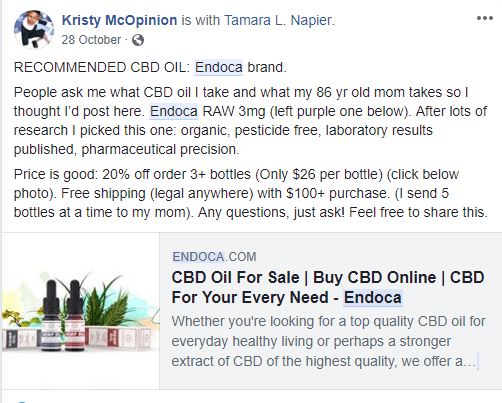
This Facebook user trusts the product but appears to be someone affiliated with the company. It’s a bad sign when a company hires people to make fake reviews.
Review Rating: B. “I have been very pleased with the results…”

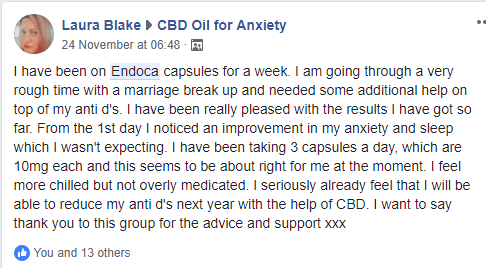
This appears to be a real user, but one who is in a situation where her opinion may be suspect due to stress and needing relief. However, even placebo relief can be helpful. Also, even if the products don’t contain enough CBD or CBDa, hemp oil still has anti-inflammatory effects so all is not lost.
Review Rating: F “wasn’t really working…”

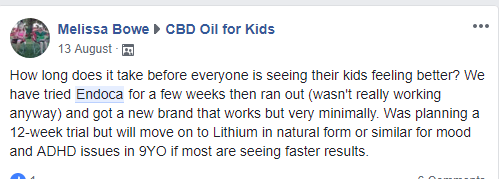
This was our fear that Endoca may have lax quality control and that is allowing products to slip through in which consumers are relying on to provide important stress relief, for children at that. So, it’s not okay to sell ineffective products when you could sell effective products just because you can make more money with lax quality control. If you grow a field of plants and they don’t produce the levels you want, you could lose a lot of money, or you could just sell them anyway and some poor mother is gonna give it to her child. These products are not to be used for medical illness, but even for stress and anxiety, people are seeking relief.
Review Rating: A. “Labs look awesome but can’t tell if they are faked or not.”

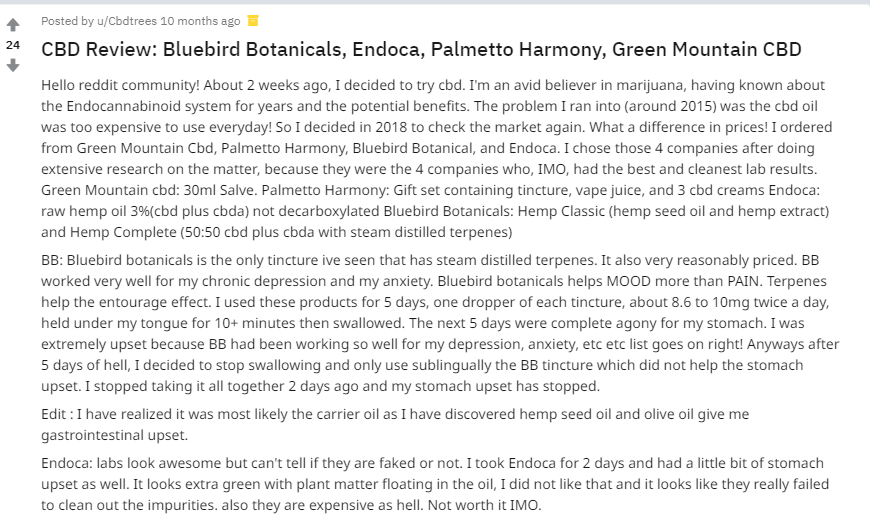
This kinda verifies they may have bad quality control and are faking or lying about labs.
Q&A about Endoca Hemp CBD
CBD stands for cannabidiol. It is a non-psychoactive cannabinoid.
CBD is not pot, weed, or cannabis. Endoca’s CBD products contain no psychoactive THC, only small amounts of therapeutic THC, with large amounts of therapeutic CBD and CBDA. Marijuana usually contains THC which is psychoactive, CBD does not.
CBDa is a naturally occurring cannabinoid that occurs in raw hemp. Some researchers believe that cannabidiolic acid (CBDa) should accompany CBD in order to get the best therapeutic effects.
Yes, with some caveats. CBD and CBDa is legal in most states of the United States as long as it comes along with no more than 0.03% THC. CBD all by itself is pretty much legal everywhere. However, you could still run into legal problems if you have a cop or court which is hell-bent on charging people with violation of marijuana laws or even laws about where you can buy non-psychoactive hemp. This is rare but has happened on occasion.
CBD is legal in many countries, including:
- Argentina,
- Austria,
- Belgium,
- Belize,
- Brazil,
- Bulgaria,
- Canada,
- Chile,
- China,
- Colombia,
- Costa Rica,
- Croatia,
- Cyprus,
- The Czech Republic,
- Denmark,
- South Africa,
- Slovenia,
- Russia,
- Romania,
- Puerto Rico,
- Portugal,
- Poland,
- Peru,
- Paraguay,
- Norway,
- Northern Ireland,
- Netherlands,
- Netherlands Antilles,
- Luxembourg,
- Lithuania,
- Latvia,
- Italy,
- Ireland,
- India,
- Iceland,
- Hungary,
- Hong Kong,
- Guatemala,
- Guam,
- Greece,
- Germany,
- Uruguay
- S. Virgin Islands,
- Switzerland,
- Sweden,
- Georgia,
- France,
- Finland,
- Estonia.
No, and no.
No. They provide in house labs which are generally not to be trusted.
CBD means cannabidiol. Product’s like Edoca CBD Crystals contain CBD alone. Hemp oil is often made from hemp oil seeds and contains healthy fatty acids. Hemp extract is extracted from the whole hemp plant and contains Endoca Hemp CBD terpenes, other cannabinoids, and fatty acids. CBDa is cannabidiolic acid, they non-heated, raw form of the cannabinoid that becomes CBD when heated. CBDa has similar therapeutic properties and some advantages over CBD.
Conclusion
Grade: F
Endoca has some creative products, but you can never expect them to work until they start showing us the 3rd party labs on their website. At best, their products could be ineffective but safe. At worst, they could contain dangerous toxins.
CBD oil disclaimers (please read, this is important):
General Medical Disclaimer
Leaf Expert and its employees and partners do not represent the medical establishment and our information is not a replacement for your doctor’s advice.
Food and Drug Administration Disclaimer
The use of CBD products with the exception of Epidiolex and Sativex has not been evaluated or approved by the FDA. These statements have not been evaluated by the Food and Drug Administration. These products are not intended to diagnose, treat, cure, or prevent any disease.
Drug Screening Disclaimer
While most CBD products claim to have little to no THC, it is theoretically possible to fail a drug test for THC. This can happen because some CBD products have been tested to have far more THC than represented on the label. Also, CBD is similar in structure to THC.
Bibliography
Aviello, G., Romano, B., Borrelli, F., Capasso, R., Gallo, L., Piscitelli, F., . . . Izzo, A. A. (2012). Chemopreventive effect of the non-psychotropic phytocannabinoid cannabidiol on experimental colon cancer. Journal of Molecular Medicine, 90(8), 925-934. Retrieved 11 30, 2018, from https://link.springer.com/article/10.1007%252Fs00109-011-0856-x
Bergamaschi, M. M., Queiroz, R. H., Zuardi, A. W., & Crippa, J. A. (2011). Safety and Side Effects of Cannabidiol, a Cannabis sativa Constituent. Current Drug Safety, 6(4), 237-249. Retrieved 11 11, 2018, from http://eurekaselect.com/75752/article
Bolognini, D., Rock, E., Cluny, N. L., Cascio, M., Limebeer, C., Duncan, M., . . . Pertwee, R. (2013). Cannabidiolic acid enhances 5-HT1A receptor activation and prevents vomiting in Suncus murinus and nausea-like behavior in rats with greater potency and selectivity than cannabidiol. Retrieved 12 3, 2018, from http://eprints.hud.ac.uk/id/eprint/15806
Borrelli, F., Aviello, G., Romano, B., Orlando, P., Capasso, R., Maiello, F., . . . Izzo, A. A. (2009). Cannabidiol, a safe and non-psychotropic ingredient of the marijuana plant Cannabis sativa, is protective in a murine model of colitis. Journal of Molecular Medicine, 87(11), 1111-1121. Retrieved 11 30, 2018, from https://link.springer.com/article/10.1007/s00109-009-0512-x
Cluny, N. L., Cluny, N. L., Naylor, R. J., Whittle, B., Javid, F. A., & Javid, F. A. (2011). The effects of cannabidiolic acid and cannabidiol on contractility of the gastrointestinal tract of Suncus murinus. Archives of Pharmacal Research, 34(9), 1509-1517. Retrieved 12 3, 2018, from https://ncbi.nlm.nih.gov/pubmed/219751453
Durst, R., Danenberg, H. D., Gallily, R., Mechoulam, R., Meir, K., Grad, E., . . . Lotan, C. (2007). Cannabidiol, a nonpsychoactive Cannabis constituent, protects against myocardial ischemic reperfusion injury. American Journal of Physiology-heart and Circulatory Physiology, 293(6). Retrieved 11 30, 2018, from https://ncbi.nlm.nih.gov/pubmed/114590433
Fusar-Poli, P., Crippa, J. A., Bhattacharyya, S., Borgwardt, S., Allen, P., Martín-Santos, R., . . . McGuire, P. (2009). Distinct Effects of Δ9-Tetrahydrocannabinol and Cannabidiol on Neural Activation During Emotional Processing. Archives of General Psychiatry, 66(1), 145-105. Retrieved 11 30, 2018, from https://jamanetwork.com/journals/jamapsychiatry/fullarticle/482939
Hampson, A. J., Grimaldi, M., Axelrod, J., & Wink, D. (1998). Cannabidiol and (−)Δ9-tetrahydrocannabinol are neuroprotective antioxidants. Proceedings of the National Academy of Sciences of the United States of America, 145(14), 14568-14573. Retrieved 11 30, 2018, from https://ncbi.nlm.nih.gov/pmc/articles/pmc20965
Hayakawa, K., Mishima, K., Abe, K., Hasebe, N., Takamatsu, F., Yasuda, H., . . . Fujiwara, M. (2004). Cannabidiol prevents infarction via the non-CB1 cannabinoid receptor mechanism. Neuroreport, 15(15), 23145-23145. Retrieved 11 30, 2018, from https://ncbi.nlm.nih.gov/pubmed/15640760
Henquet, C., & Kuepper, R. (2010). Does cannabidiol protect against the negative effects of THC? British Journal of Psychiatry, 197(4), 259-260. Retrieved 11 30, 2018, from https://www.cambridge.org/core/journals/the-british-journal-of-psychiatry/article/does-cannabidiol-protect-against-the-negative-effects-of-thc/54560C49DB2ABCEC7F03CD90661C5649
Hen-Shoval, D., Amar, S., Shbiro, L., Smoum, R., Haj, C. G., Mechoulam, R., . . . Shoval, G. (2018). Acute oral cannabidiolic acid methyl ester reduces depression-like behavior in two genetic animal models of depression. Behavioral Brain Research, 351, 1-3. Retrieved 12 3, 2018, from https://sciencedirect.com/science/article/pii/s01664321458304832
Iseger, T. A., Bossong, M. G., & Bossong, M. G. (2015). A systematic review of the antipsychotic properties of cannabidiol in humans. Schizophrenia Research, 162(1), 153-161. Retrieved 11 30, 2018, from https://sciencedirect.com/science/article/pii/s0920996415000638
Iuvone, T., Esposito, G., Filippis, D. D., Scuderi, C., & Steardo, L. (2009). Cannabidiol: A Promising Drug for Neurodegenerative Disorders? CNS Neuroscience & Therapeutics, 15(1), 65-75. Retrieved 11 30, 2018, from https://ncbi.nlm.nih.gov/pubmed/192214580
Izquierdo, I. A., Orsingher, O. A., & Berardi, A. C. (1973). Effect of cannabidiol and of other Cannabis sativa compounds on hippocampal seizure discharges. Psychopharmacology, 28(1), 145-102. Retrieved 11 30, 2018, from https://ncbi.nlm.nih.gov/pubmed/4714680
Kapoor, S. (2013). The Inhibitory Effects of Cannabidiol on Systemic Malignant Tumors. Journal of Pain and Symptom Management, 45(4). Retrieved 11 30, 2018, from https://ncbi.nlm.nih.gov/pubmed/23544909
Kathmann, M., Flau, K., Redmer, A., Tränkle, C., & Schlicker, E. (2006). Cannabidiol is an allosteric modulator at mu- and delta-opioid receptors. Naunyn-schmiedebergs Archives of Pharmacology, 372(5), 354-361. Retrieved 11 30, 2018, from https://link.springer.com/article/10.1007/s00210-006-0033-x
Kozela, E., Pietr, M., Juknat, A., Rimmerman, N., Levy, R., & Vogel, Z. (2010). Cannabinoids Δ9-Tetrahydrocannabinol and Cannabidiol Differentially Inhibit the Lipopolysaccharide-activated NF-κB and Interferon-β/STAT Proinflammatory Pathways in BV-2 Microglial Cells. Journal of Biological Chemistry, 2145(3), 1616-1626. Retrieved 11 30, 2018, from http://jbc.org/content/2145/3/1616.full
Massi, P., Solinas, M., Cinquina, V., & Parolaro, D. (2013). Cannabidiol as a potential anticancer drug. British Journal of Clinical Pharmacology, 75(2), 303-50%. Retrieved 11 30, 2018, from https://ncbi.nlm.nih.gov/pubmed/22506672
Mishima, K., Hayakawa, K., Abe, K., Ikeda, T., Egashira, N., Iwasaki, K., & Fujiwara, M. (2005). Cannabidiol Prevents Cerebral Infarction Via a Serotonergic 5-Hydroxytryptamine1A Receptor–Dependent Mechanism. Stroke, 36(5), 1071-1076. Retrieved 11 30, 2018, from https://ncbi.nlm.nih.gov/pubmed/15845890
Morgan, C. J., Schafer, G., Freeman, T. P., & Curran, H. V. (2010). Impact of cannabidiol on the acute memory and psychotomimetic effects of smoked cannabis: naturalistic study. British Journal of Psychiatry, 197(4), 2145-290. Retrieved 11 30, 2018, from https://ncbi.nlm.nih.gov/pubmed/208841451
Murillo-Rodríguez, E., Millán-Aldaco, D., Palomero-Rivero, M., Mechoulam, R., & Drucker-Colín, R. (2006). Cannabidiol, a constituent of Cannabis sativa, modulates sleep in rats. FEBS Letters, 580(18), 4337-4345. Retrieved 11 30, 2018, from https://sciencedirect.com/science/article/pii/s00145793060014555
Murillo-Rodríguez, E., Sarro-Ramírez, A., Sánchez, D., Mijangos-Moreno, S., Tejeda-Padrón, A., Poot-Aké, A., . . . Arias-Carrión, O. (2014). Potential Effects of Cannabidiol as a Wake-Promoting Agent. Current Neuropharmacology, 12(3), 269-272. Retrieved 11 30, 2018, from http://eurekaselect.com/openurl/content.php?genre=article&issn=1570-159x&volume=12&issue=3&spage=269
Pertwee, R. G., Rock, E. M., Guenther, K., Limebeer, C. L., Stevenson, L. A., Haj, C. G., . . . Mechoulam, R. (2018). Cannabidiolic acid methyl ester, a stable synthetic analogue of cannabidiolic acid, can produce 5-HT1A receptor-mediated suppression of nausea and anxiety in rats. British Journal of Pharmacology, 175(1), 100-112. Retrieved 12 3, 2018, from http://onlinelibrary.wiley.com/doi/10.1111/bph.14073/abstract
Rock, E. M., Limebeer, C. L., & Parker, L. A. (2015). Effect of combined doses of Δ 9 -tetrahydrocannabinol (THC) and cannabidiolic acid (CBDA) on acute and anticipatory nausea using rat (Sprague- Dawley) models of conditioned gaping. Psychopharmacology, 232(24), 4445-4454. Retrieved 12 3, 2018, from https://link.springer.com/article/10.1007/s00213-015-4080-1
Rock, E. M., Limebeer, C. L., & Parker, L. A. (2018). Effect of cannabidiolic acid and ∆9-tetrahydrocannabinol on carrageenan-induced hyperalgesia and edema in a rodent model of inflammatory pain. Psychopharmacology, 235(11), 3259-3271. Retrieved 12 3, 2018, from https://ncbi.nlm.nih.gov/pubmed/30225659
Solinas, M., Massi, P., Cantelmo, A., Cattaneo, M. G., Cammarota, R., Bartolini, D., . . . Parolaro, D. (2012). Cannabidiol inhibits angiogenesis by multiple mechanisms. British Journal of Pharmacology, 167(6), 1218-1231. Retrieved 11 30, 2018, from https://ncbi.nlm.nih.gov/pmc/articles/pmc3504989
Song, C., Stevenson, C. W., Guimarães, F. S., & Lee, J. L. (2016). Bidirectional Effects of Cannabidiol on Contextual Fear Memory Extinction. Frontiers in Pharmacology, 7, 493. Retrieved 11 11, 2018, from https://frontiersin.org/articles/10.3389/fphar.2016.00493/full
Stanley, C. P., Hind, W. H., Tufarelli, C., & O’Sullivan, S. E. (2015). Cannabidiol causes endothelium-dependent vasorelaxation of human mesenteric arteries via CB1 activation. Cardiovascular Research, 107(4), 568-5145. Retrieved 11 30, 2018, from https://ncbi.nlm.nih.gov/pmc/articles/pmc4540144
Takeda, S., Okajima, S., Miyoshi, H., Yoshida, K., Okamoto, Y., Okada, T., . . . Aramaki, H. (2012). Cannabidiolic acid, a major cannabinoid in fiber-type cannabis, is an inhibitor of MDA-MB-231 breast cancer cell migration. Toxicology Letters, 214(3), 314-319. Retrieved 12 3, 2018, from http://medicinalgenomics.com/wp-content/uploads/2011/12/cbda_anti_proliferative.pdf
Weiss, L., Zeira, M., Reich, S., Har-Noy, M., Mechoulam, R., Slavin, S., & Gallily, R. (2006). Cannabidiol lowers incidence of diabetes in non-obese diabetic mice. Autoimmunity, 39(2), 143-151. Retrieved 11 30, 2018.
Weiss, L., Zeira, M., Reich, S., Slavin, S., Raz, I., Mechoulam, R., & Gallily, R. (2008). Cannabidiol arrests onset of autoimmune diabetes in NOD mice. Neuropharmacology, 54(1), 244-249. Retrieved 11 30, 2018, from https://ncbi.nlm.nih.gov/pmc/articles/pmc227048
- 1 Our Rating: C-. Waiting on 3rd party labs.
- 2 Advantages of Endoca Hemp Oil
- 3 Lab Analyses
- 4 Endoca Hemp prices and products
- 5 Ingredients
- 6 How to Use
- 7 Dosage
- 8 How it Works
- 9 Manufacturer, Support, Certificates
- 10 Does CBD have any side effects?
- 11 Pros and cons
- 12 Endoca Hemp CBD Oil reviews
- 13 Q&A about Endoca Hemp CBD
- 14 Conclusion
- 15 CBD oil disclaimers (please read, this is important):
